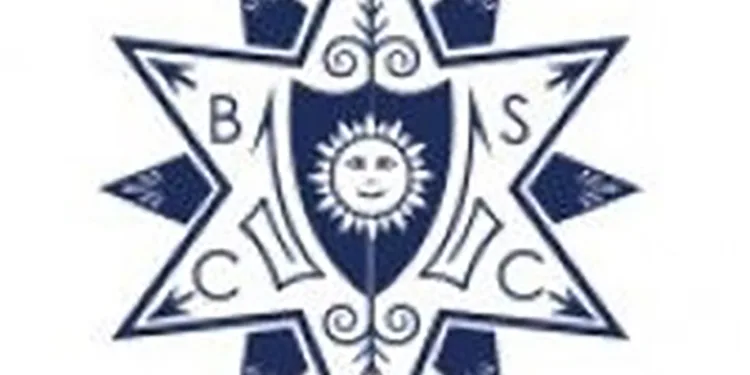Discover the intriguing story behind Banbury’s oldest cycling clubs – Banbury Cyclists’ Club and Banbury Star Cyclists’ Club.
Uncover how the Banbury Cyclists’ Club was established in 1875, and how the Banbury Star Cyclists’ Club was formed in 1891, leading to questions about a possible merger or takeover. Learn about the friendly relationship between the two clubs, and how the Banbury Star Cyclists’ Club ultimately became the larger of the two. Explore the growth of cycling in the 1800s, with the advent of the “safety bicycle” and the pneumatic tire, and how Banbury was at the epicentre of this exciting craze. The club remains in a healthy state today, with membership around 230 members, which they believe is the highest in its history.
Banbury Star Cyclists’ Club was established in 1891.
However, the club is in possession of a framed montage of photos (below) with the title “Banbury Cyclists’ Club – Established 1875 – The oldest cycling club in the world” and the Lord Mayor of Banbury is named as club president.
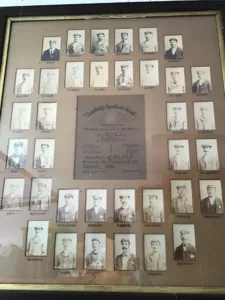
This is some 16 years prior to the founding of Banbury Star CC (BSCC), which begs the question: could the two clubs have merged, or was there some form of takeover? Recent research has now uncovered what actually happened around that time, as well as some interesting facts regarding cycling in those early days.
Both Banbury clubs were certainly amongst the earliest cycling clubs in the UK, although the first is generally accepted to be the Pickwick Bicycle Club. This club, which is still going today, was formed in June 1870, when six cycling enthusiasts met at the Downs Hotel, Hackney Downs, East London.
Confirmation of the formation of The Banbury and District Bicycle Club, as it was first known, and the enrolment of 26 members, was printed in the Banbury Advertiser on 11th February 1875. The word District was dropped after a couple of years and then following the annual meeting in 1883, the club took the decision to use its final iteration of the Banbury Cyclists’ Club (BCC).
Their first ever club ride took place on March 29th 1875 from Banbury Cross, with seven riders taking their “ordinaries” (Penny Farthing style cycle) on a 61 mile ride up to Coventry and back.
Confirmation of the creation of the new Banbury Star Cyclists’ Club, can also be found in the Banbury Advertiser, dated Thursday 12th February 1891, it recorded “Formation of the Banbury Star Cyclists’ Club announced – Mr. J Phillips as secretary, Mr. J. Kilsby as treasurer and Mr. E. Allit as captain, along with Mr. E. Barden as bugler. No mention was made of Banbury Cyclists’ Club in the announcement.
What has now been discovered – as the result of the club commissioning George Hughes, a member of Banbury Historical Society, to conduct some research – is that the two clubs existed quite amicably. For instance, club officers often attended each other’s annual dinners. Amalgamation was often discussed and proposed, but nothing ever happened. Records show that a number of members did move from BCC to BSCC and in particular, Banbury Star’s first President Mr C. F. Edmunds, was one of the first Vice-Presidents of BCC.
A report of an after-dinner speech given by Mr Edmunds in 1895 has been uncovered, where he said “He would not enter into a discussion on amalgamation. When he consented to become president of the Star Cyclists’ Club, he did so on the understanding that there was no rivalry between the two clubs and that was the only condition on which he would be its president. There was perfect harmony between the two clubs and he was very glad to see members of the Star Club present that evening. He was pleased to be the president of one club and a vice-president of the other and would leave the question of amalgamation to the working members.
It does appear though that BSCC soon became the larger of the two clubs and at the turn of the century the BCC membership and club ride numbers gradually declined. The club membership at 7s.6p., later reduced to 5s., was quite expensive for the time, which may have been a contributing reason. Eventually, the decline became too much for the Banbury Bicycle Club and although its exact demise cannot be fixed, it is thought to have been circa 1908.
If amalgamation had gone ahead, then Banbury Star Cyclists’ Club could justifiably claim to be one of the oldest cycling clubs in the world and would be close to celebrating its 150th anniversary, but the opportunity was lost. However, it is proven that Banbury was at the epicentre of the growth of cycling from its very earliest days.
So, what were bicycles like in the 1800s? The first appeared in Germany in around 1816, but it was pushed along by the feet and had no pedals. In the early 1860s the first true bicycle was created in Paris by attaching rotary cranks and pedals to the front wheel hub. The well-known “Penny Farthing” style of bicycle was invented in 1871. It was in the 1890s that the bicycle craze seriously took off, following the development of the “safety bicycle” with its chain-drive transmission, and the subsequent invention of the pneumatic tyre. The first well known chain-drive bicycle was the “Rover” produced in 1886 by John Kemp Starley, which is on display at nearby British Motor Museum, Gaydon.
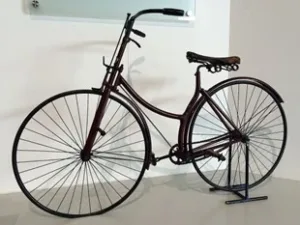
The 1886 Rover “safety bicycle” is on display at the British Motor Museum
Banbury was clearly very much at the forefront of this bicycle craze with as we now know, not one, but two of the oldest cycling clubs in the country. There are a couple of possible reasons for this. A new bicycle in 1890 would have cost you around £12, which for the time was quite expensive. At this time though, Banbury was a very prosperous town and this is reflected in the early membership which comprised many local dignitaries and influential people who were evidently able to afford a new bicycle.
Added to this nearby Coventry was already establishing itself as a world leader in bicycle manufacturing. Bicycles were also made in Banbury and the first evidence of this is in an advert carried by the Banbury Guardian, dated Thursday 22nd July 1869, for the Vulcan bicycle manufactured by Charles Lampitt at his Vulcan Foundry in Neithrop. Interestingly the two agents licenced to sell the bicycle were William G. Thomas and R. R. Thomas, who were among the founders of the Banbury Cyclists’ Club.
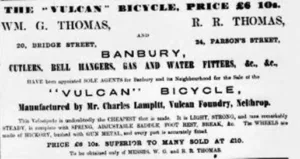
1869 – advert in Banbury Guardian
Records held by the club start with a book of committee and AGM minutes dated 1903 to 1929. Its history prior to that is still vague, although we do have details of all the club’s main officers in the year the club was founded, 1891. As stated above, the first club president was Charles F Edmunds, a millionaire partner in his family brewing firm. There were no fewer than five Vice-Presidents, L M Wynne, who stood for Banbury as an MP in 1892, W H P Jenkins, who lived at Upton House, B Samuelson, an industrialist who was later knighted, Rev. C F Porter, who became canon of Christ Church Cathedral, Oxford and Lord North, who was the last Lord to live at Wroxton Abbey.
It’s not clear how long Mr Edmunds remained president. He died in 1907, but by 1903 that title passed on to the 4th Earl of Effingham (Henry Alexander Gordon Howard). The Earl was president for over 20 years until his death in May 1927. We know that during his stewardship, many club rides rode out to Tusmore, his ancestral home. The longest serving president was John Broughton, who held the position for over 30 years until 1981. He died in 2017 aged 90.
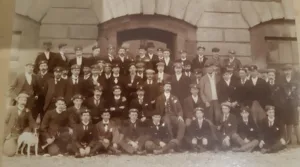
The first club photo in our possession, believed to be early 1900s and possibly taken at Tusmore
The popular belief is the name, Banbury Star, came about due to the fact that most of the club’s early rides took place in the evening, often under the stars. However, research has shown that it may have been adopted to clearly distinguish it from Banbury Cyclists’ Club as the word Star and bicycle club was used throughout the UK. Star it’s believed originated from the double star arrangement of the spokes on the first safety machines. A quick search of the newspapers of 1880s and 1890s throw up at least 15 clubs in the UK having ‘Star Bicycle’ or ‘Star Cyclists’ in their name.
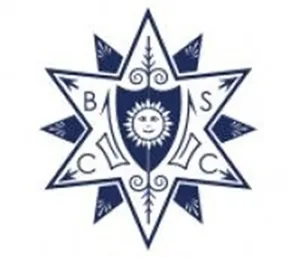
1891 – the Star crest
The club’s inaugural run was on Friday 10th April 1891 from Banbury Town Hall to Middleton Cheney, departing at 7:30pm. In its early years, twice weekly runs were the main activities of the club. On the sporting side, grass track racing was very strong and the club joined the Banbury Harriers for many years in their Annual Whit Monday Sports Meeting. Probably like other clubs around that era, many other social activities were organised like smoking concerts, dances, swimming days and whist drives. The club was even a member of the local Air Gun League. Early membership numbers were around 70, with a membership fee of 1 shilling in 1903.
During the 1920s the club produced probably its finest rider, Eddie T Rixon, who set many local records which were not bettered until the arrival of Eric Wooton in the 1940s. The Edmunds Cup, the oldest trophy in the club’s possession, carries the names of both Rixon and Wooton.

First awarded in 1913, the Edmunds Cup is the club’s oldest trophy
Whilst the earlier BCC did appear to admit women members, like many other clubs and organisations at the turn of the century, Banbury Star was very much a male only club and this lasted right up until 1935. Whilst all women won the right to vote by 1928, the club was slow to react and change. At an Extraordinary General Meeting, held on the 9th April, a motion was proposed by Mr A W Cotterell and then passed to admit women members. The annual subscription was then set at 2s.6d for men and 2s.0d for women. The first woman member was Mrs Vi Thomas, who became a Vice-President, with Miss E Dale and Miss Baker becoming committee members.
Time trials have always been the bedrock of the club’s sporting activities and on 20th June 1937 the club held its first Open TT. The 25-mile course was from Banbury to Sturdy’s Castle, Kidlington and back and there were 27 entries. The club now runs two very successful Open TTs every year. The first is the Hardriders 23 Mile TT, which was first held on 26th February 1989. A very tough season opener, it always attracts a strong entry for the Broughton Cup. Held on the A422 Stratford Road, starting and finishing at Wroxton, the course runs out to Ettington, returning with a climb of Sunrising Hill. In September 2019 a second Open TT was organised on a new 10-mile course on the B 410 between Warmington and Gaydon.
The club’s real success story, however, is its popular summer series of weekly TTs. They are held every Wednesday evening between March and September on a range of around 9 different courses, with distances from 5 to 30 miles in length. These popular events continue to grow and always attract members from visiting clubs, which often include some professional riders. Former British National U23 Champion and now World Tour rider Charlie Quarterman, holds several of the club’s outright course records. A lot of this success has been down to the organisation and enthusiasm of long-time member and time keeper Keri Williams.
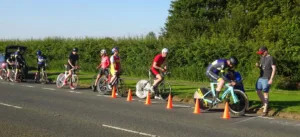
Wednesday evening time trials remain one of the club’s highlights
It was not until 1954 that the club held its first Open Road Race, despite club minutes showing numerous attempts to organise one. The first race took place on Sunday 11th July and comprised four laps, a total of 75 miles, on a circuit, south of Banbury based around the villages of Deddington, Enstone and Hopcrofts Holt. It is not exactly known for how long races were held on this course, but we do know that a new course was created in 1970. Held close to Banbury centre, on what became known as the Queensway Circuit, this race was an integral part of the annual Banbury Cavalcade of Sport weekend. The first race, organised by Mr G Walton, was held on 12th September 1970 over eight laps, a total of 48.8 miles. Due to its central location and over a sporting weekend, it often drew large crowds and was usually started by the town Mayor or Chairman of Cherwell DC. Due to increasing volumes of traffic, the event ceased, its last race being won by Simon Lillystone in 1993.
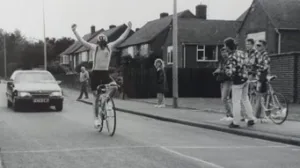
The winner, unfortunately unknown, crosses the finishing line on the Queensway Circuit
It was not until 2002 that the club found its current 45-mile, three-lap course on the outskirts of Banbury, which takes in multiple climbs of Edge Hill. The first race, organised by Keri Williams and sponsored by construction company Bluestone, was held on 9th June and was won by Phil Blacker (Wyre Forest CRC). As well as the men’s Cat 3/4 race, the event now includes a round of the British Women’s National Team Championships, attracting some of the country’s leading up and coming riders.
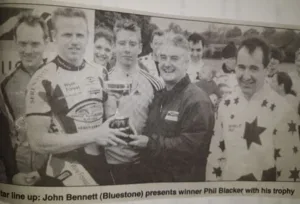
2002 – our first road race on the current course – organiser Keri Williams far right
In April of 1991, the club’s centenary year, there was a repeat of the inaugural run to Middleton Cheney in April. The club also promoted the National Junior 25 miles Championship Time Trial in August, which was won by Christopher Saunders (Port Sunlight Wheelers) in 53 minutes 21 seconds. On 30th November representatives of many national cycling organisations and dignitaries together with members and ex-members attended the dinner and prize presentation.
Then in 2016 to celebrate its 125th anniversary, the club released a limited-edition jersey and shorts, in time for a commemorative ride on the 10th April from Banbury’s Town Hall to Middleton Cheney, again recreating the very first ride. The town’s Deputy Mayor, Cllr Gordon Ross, starting the 65 cyclists on their circular route that took in Little Bourton, Cropredy, Aston le Walls, Culworth and Marston St Lawrence.
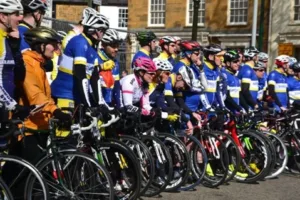
2016 – club members gather for the 125th anniversary ride
Then, bringing us almost up to date we have the infamous year of 2020 – the year of the Covid-19 pandemic. This resulted in the cancellation of the annual road race and most of the Wednesday evening time trials, but on those we could run Luke Norris set five new club records. All five of our weekend rides were cancelled from mid-March until early July so the club turned its attention to helping the community of Banbury. It immersed itself in delivering medical prescriptions by bicycle during the period of lockdown when the vulnerable were shielded at home. We delivered over 3,500 items and rode over 3,000 miles in the process and achieved national publicity for our efforts. In addition to this, we helped service and safety check 120 bikes which were then given to essential workers or members of the community who wanted to be part of the huge increase in the interest in cycling. As a result of this, club president Paul Dean, was presented with an award certificate by Amanda Ponsonby, the High Sheriff of Oxfordshire, in recognition of the club’s services to the community.
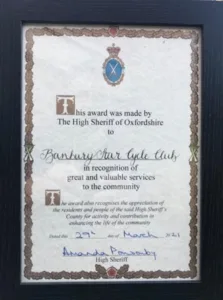
2021 – the High Sheriff of Oxfordshire’s award
One further interesting fact discovered researching the club’s history was the role of the club bugler. The earliest club photo, taken around 1900 and shown above, clearly shows a man with a bugle (second left, front row) – probably Mr E. Barden. The club bugler was an important person in cycling club life in the early 1890s. On club rides, he rode next to the club captain and used his bugle to call out signals to other riders: to speed up, slow down, dismount, or ride single or double file. The club minutes also reveal there was always a sub-bugler and both posts changed on a fairly regular basis. It would seem that the role of the club bugler ended sometime in the 1930s.
Compiled by Roger Gollicker, with help from club president Paul Dean and research provided by George Hughes, a member of Banbury Historical Society.
Banbury Star Cyclists’ Club has a rich and fascinating history that is intertwined with the very origins of cycling itself. Whether you are an experienced rider or a complete beginner, becoming a member of the club is a fantastic way to connect with like-minded people, discover new routes, and explore the beautiful countryside surrounding Banbury.
As a member of the club, you will have access to a range of benefits, including regular rides, social events, and the opportunity to participate in races and competitions. You will also benefit from the experience and knowledge of our seasoned riders, who can offer advice and support to help you develop your skills and achieve your cycling goals.
So why not join us today and become part of Banbury’s rich cycling heritage? With our friendly and welcoming community, you are sure to find a warm reception and plenty of opportunities to enjoy the thrill of the open road. To find out more about membership and how to join, visit our website or get in touch with us today. We look forward to welcoming you to the Banbury Star Cyclists’ Club!
Visit the club webstie to learn more.

